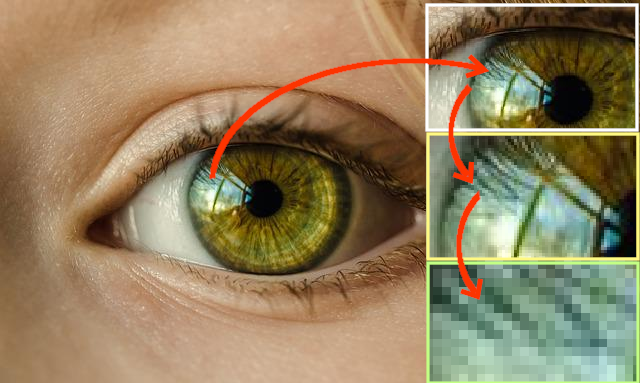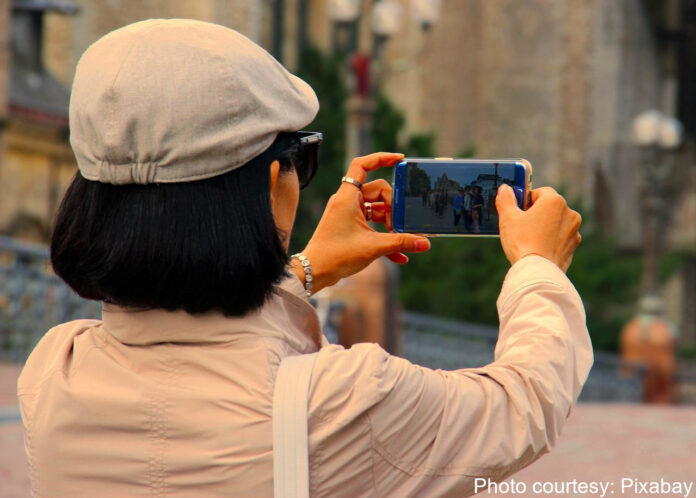Manoj Pandey*
A commoner’s guide to pixel-count in his mobile camera
In 2022, Samsung, Moto, Realme, Xiomi, etc, are bragging about smartphone models with 108-megapixel cameras in them. Consider these pixel numbers against the earliest cameras on mobile phones, two decades back, that had just 0.2-megapixel resolution.
Recently there was a news report that Samsung was trying to bring a 576-megapixel camera on its smartphones in three years from now.
The more the merrier, it seems.
Megapixel becomes a deciding factor
There is cut-throat competition in the arena of mobile devices, and companies fall over each other in showcasing such features as would give their devices an edge over competition. The top challenge is to give the largest and most brilliant display, and pack maximum power/ speed. After that come the specs that add value but are seldom fully harnessed by the users. The megapixel count of the camera is among the most hyped specifications.
It seems that mobile phone makers find it easy to influence buyers, especially of premium models, with megapixel numbers. Once a company manages to stuff a high-resolution (read, more megapixels) camera inside a phone, its brochures and other publicity material focus on the camera more than other features. Since ‘a photograph is worth a thousand words’, showcasing a photograph (or a video) supposedly taken with that camera works well in selling the smartphone.
Besides the gratification that the capability to shoot stunning photos and videos gives, the buyer also gets influenced by the way the numbers behave. Companies play with different numbers such as screen size and resolution, battery life, memory and space. Cameras come handy here: you like to have 4 lenses instead of one or two, and you tend to go for 64 or 108 MP resolution as compared to 24 or 48 MP in the competitor’s model (or a lower-end model of the same company).
I know people who bought expensive mobile phones with 5 MP camera when the mid-range phones had 2 MP cameras, and upgraded to 32 MP camera when others had just 8 MP or 16 MP cameras on their phones – touting their MPs all the time but hardly using the camera.
Mobile phone cameras have indeed come a long way
There is no doubt that digital camera technology has grown by leaps and bounds in the last two decades. Many constraints of the smartphone – the topmost being the small size and thinness of the device, and the small size of lens that it can pack – have been over-compensated by miniaturisation, higher sensor capabilities, software enhancements, etc. Now, some smartphone cameras rival earlier SLRs, at least in certain situations. The videos taken by the latest smartphone cameras are much better than those taken by earlier VHS cameras in many respects. In fact, smartphone cameras also rival semi-professional digital cameras in being much more versatile, easier to operate, and integrated with other apps.
If you recall your Class-VI physics chapter on how a camera works, the camera works by focusing light from objects to a sensitive surface inside the camera, using a round (convex) lens. Though the fundamental remains the same, the camera gets more and more complex and expensive as it is made to shoot pictures (and videos) in high quality.
In traditional (=analog/ non-digital) photography, the image is captured on the photo-sensitive surface of a camera reel, and the reel is then ‘developed’ in a photo-lab to produce photos on paper.
Digital photography took birth essentially by replacing the photo-sensive surface; other things followed. The photo in digital cameras is captured in the form of digital signals on a sensor rather than chemical reaction on a photo-sensitive layer. The ‘sensor’ inside the digital camera can capture signals very precisely, and it can be used again and again. With recent advancements in sensor technology, it is now possible to capture immensely fine details of light and colour even with small sensors that can fit inside a smartphone.
As more and more hardware functions are being taken over by software, more punch is being packed into mobile cameras. Progressively, it has become possible to shoot extra-ordinarily rich photographs and videos through mobile cameras, and with filters and effects that cost a ton in case of professional cameras. Thanks to the use of artificial intelligence, the camera is capable of making decisions even better than a mid-level professional, and the results are instant.
Enter the megapixel!
One important measure of the sensor’s capabilities is the size of picture the camera can take. This is measured in pixels. ‘Pixel’ is the smallest unit that makes the photo (and video, which is nothing but a collection of images that show up one after the other at a fast speed). Suppose you have a photo that has 10 pixels in its width and 5 pixels in height. It will have 50 pixels in all. On a PC or laptop (which normally displays nearly a hundred pixels in an inch), this photo will look like a tiny (1/10 inch wide, 1/20 inch tall) spot.
Size of the photo in terms of pixels matters. If you open the above tiny photo in a photo viewing software and enlarge it, the photo would become big but its individual pixels would start showing up. The more you zoom in, the more pixelated the picture looks. The picture given here shows how the reflection of hair on the lady’s iris looks pixelated when we enlarge it.

Now consider a photo that should not look pixelated when you display it on the full screen of your 15.6-inch laptop. A 15.6-inch laptop’s screen is about 14.7 inch wide and 9.7 inch tall. In normal setting, most laptops display less than 100 pixels per inch. So, the photo should have about 1470 pixels in width and 970 pixels in height so that it looks OK on this screen. The minimum number of pixels required for looking fine on this monitor will be 1470 x 970 = 1,430,000 = 1.43 million pixels = 1.43 MP. That means a picture of nearly 1.5 MP size can appear fine (if other qualitative aspects of the photo are good) on a laptop monitor. For the same reason, even smaller photos would look perfectly fine on a tab and smartphone monitor.
So, about 1.5MP photo size is good enough for a laptop screen.
Now consider that you want to print the photo. Normal photo printing is done at 300 dots per inch. This dots-per-inch (DPI) measurement is not pixels-per-inch, but the two work more or less parallel. So, for printing a postcard-size photo, the minimum pixel size required would be 6 inch x 4 inch x 300 x 300 = 2,160,000 pixels = 2.2 MP.
It helps to go for a slightly higher pixel-count, so that you have the liberty to crop, resize and fine-edit the picture or video. Consider this too, and you will realise that 5 MP camera is more than enough for most situations.
What if you want to print your pictures for framing? Let us extend the above calculations to the photo print of 16.5 inch x 11 inch. This size of print would need pixels 8-9 times those needed for a postcard-size print. That takes the required pixel count to around 16 MP. Photo prints that are to be seen from a distance can, in fact, breach the pixel limit and can be slightly pixelated. Thus, with a 16 MP photo, you can take printout of one inch more to each side, and the print would still look fine. That settles the pixel size for a photo-print of this size. However, if you intend to frame a photograph, I would advise that you shoot the photo with a professional camera.
If you are a frequent traveller and maintain a travel blog, you can go for a mobile phone with good camera – and for that too, 16-24 MP should be enough. Having a mobile phone with a similar camera makes sense, also if you are an ardent photographer and use the mobile phone as a standby device. In such cases, you should be looking for not only high pixel-count but also other quality aspects of the camera, e.g. sensor size, different shooting modes available, optical zoom, low-light shooting capabilities, software enhancements and so on.
If you do a lot of fine editing on your pictures/ videos, these pixel sizes would not suffice. However, would you not like to use a professional photo/ video camera for such purposes? Another user case requiring a higher pixel count in photos/ videos could be that you regularly view your pictures and videos on a large-screen television or projector. But I doubt if those buying smartphones laden with cameras of 64 MP or even higher pixel-count buy the smartphone with such activities in mind.
Pixels are like physical coloured dots but they actually are not; they are pieces of data rather than precise colours and light. Beyond their sheer number, the quality of sensors, lens and associated hardware and software play a big role in determining the final quality of picture (and video).
In fact, stuffing too many pixels in a small sensor can mar the quality of the photograph rather than enhancing it. Higher resolution may also mean more chances of camera shake unless a strong ‘image stabilization’ mechanism is in place. A finely built 16 MP camera can give much better results than a 108 MP camera with poor optics. Of course, we are not even considering the photographic sense of the person behind the camera.
Let us also quickly check how megapixels work in the case of videos. The measurements do not work exactly the same in the case of videos, as usually videos and monitors are not measured in terms of total pixels. Earlier the digital videos/ monitors/ televisions were measured in terms of vertical size in pixels (e.g. 720p HD video has 1280 pixels in width and 720 pixels in height) and the bigger ones are now measured in horizontal pixel count (e.g. 4k video has nearly 4000 pixels in width; to be exact, it is 3840 x 2160 pixels or nearly 8.3 MP). Due to the processing required inside the camera in producing a video out of photo-frames, the resultant video is usually of a lower resolution than the pixel-count that the camera boasts of.
Do professional photographers go for a much bigger pixel count?
It will be interesting to compare the megapixel game being played in the smartphone market with that in the professional camera space.
The range of professional cameras is mind-boggling, depending upon the purpose for which they are used. So, let us focus on general purpose professional photography, leaving aside highly specialized fields such as deep-water photography, microscopic photography and astronomical photography.
Interestingly, because such cameras are purchased by professionals, there is not as much competition in terms of pixel-count there as in the case of mobile cameras! The best cameras in the professional still talk about 50 – 100 MP resolution though some cameras use software or hardware tricks to produce bigger-resolution photographs. One oft-used technique for doing so is ‘sensor-shift’, in which the sensor takes many photographs while shifting to a side – and then the photos are stitched together to produce a bigger photograph.
Top professional cameras have ‘full-frame’ sensor, supported with high-quality hardware. A range of controls in the form of shutter speeds, apertures and zoom levels are available. The lenses are of professional class, and can capture a very high range of colours without camera distortions.
Many world-class professional photographers have gone on record saying that they have stopped chasing megapixels after reaching a mid-level (24, 36 or at best 50 MP). Most professionals keep their photography and video functions separate, and focus on one aspect – and buy a camera that excels for their kind of work.
The commoner’s takeaway
If you use your smartphone for shooting photos and videos more than an occasional click, you should look for all aspects of the camera. Browse reviews that analyse the phone’s sensor and other qualitative aspects. A bit of optical zoom is always welcome. If there are many lenses in the smartphone fixed side by side, one of them should have a bit of zoom. A higher megapixel count should not come at the cost of other spects. Unless you have a special requirement, 8 to 16 MP should be quite sufficient for the rear camera of your smartphone. More than this resolution is welcome, only if it is not the deciding factor.
******

Manoj Pandey is a former civil servant. He does not like to call himself a rationalist, but insists on scrutiny of apparent myths as well as what are supposed to be immutable scientific facts. He maintains a personal blog, Th_ink
Disclaimer: The views expressed in this article are the personal opinion of the author and do not reflect the views of raagdelhi.com which does not assume any responsibility for the same.




… [Trackback]
[…] Find More Info here on that Topic: raagdelhi.com/how-many-mega-pixels-do-you-need-in-your-smart-phone-camera/ […]
… [Trackback]
[…] Information on that Topic: raagdelhi.com/how-many-mega-pixels-do-you-need-in-your-smart-phone-camera/ […]
… [Trackback]
[…] Here you will find 2370 additional Info on that Topic: raagdelhi.com/how-many-mega-pixels-do-you-need-in-your-smart-phone-camera/ […]